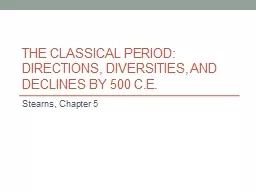

Stearns Chapter 5 Importance of the Classical Period Importance of the Classical Period Problems with Expansion New territorynew people New people have different customs values Issue of maintaining unity and deference ID: 257559
Download Presentation The PPT/PDF document "The Classical Period: Directions, Divers..." is the property of its rightful owner. Permission is granted to download and print the materials on this web site for personal, non-commercial use only, and to display it on your personal computer provided you do not modify the materials and that you retain all copyright notices contained in the materials. By downloading content from our website, you accept the terms of this agreement.
Slide1
The Classical Period: Directions, Diversities, and Declines by 500 C.E.
Stearns, Chapter 5Slide2
Importance of the Classical PeriodSlide3
Importance of the Classical PeriodSlide4
Problems with Expansion
New territory=new people
New people have different customs, values
Issue of maintaining unity and deferenceSlide5
Territorial Challenge of Integration
China
Government settles Northerners into new Southern regions.
India
Use of Hinduism and the caste system.
RomeGenerous local autonomy and toleranceExpansion of citizenship
Use of commerce in an interdependent networkSlide6
Social Challenges of Integration
Always an assumption of inequalities
Gender inequality
China uses Confucianism
India uses Hinduism
Rome not as rigid, but not openEconomic and Social inequalityChina uses ConfucianismIndia uses Hinduism (think caste system)
Challenged by Buddhism
Rome uses slavery, citizenship
China and India more successful in integrating
Just look at what happens in the WestSlide7
Developments Outside the Three Classical Civilizations
Location matters
Bordering a classical civilization means
Trade network
Diffusion of belief systems (e.g. Buddhism, Christianity)
Northeastern AfricaBorders Egypt; influence from Greeks, Romans, and Persians Japan
Borders China
Southeast Asia
Borders India and China
Northern Europe
Borders Roman Empire (West and East)
BUT the Americas, Polynesia, and Sub-Saharan Africa are more autonomousSlide8
KushSlide9
Northeastern Africa
The Kush
adopt hieroglyphic writing
adopt belief in the king’s divinity
Axum and Ethiopia
Clear ties to the Eastern MediterraneanTrade with JewsTrade with GreeksAdoption of Judaism and Christianity
Introduction of classical knowledge
Iron working
Monarchial patterns
Agricultural patternsSlide10
JapanSlide11
Japan
Populated by migrations from Korea stopped by 300 C.E.
Migrants bring knowledge from Chinese-zone, but no elaborate contact with China
Iron working
Agriculture
Strict social differencesShintoismDistinctive to Japan
Worship of political rulers and spirits of nature
Unified “national” religion by 700 C.E.
Political unity
Starts out decentralized (a la Greece and India)
Increased centralization leads to more elaborate contact with China (c. 600 C.E.)Slide12
Europe, 500 C.E.Slide13
Northern Europe
Loosely organized regional kingdoms
Teutonic people (Germany)
Celtic people (England)
Norsemen (Scandinavia)
Slavic people (Eastern Europe)Primitive agriculture paired with hunting for foodSome maritime progress in Scandinavia
Polytheistic religion
Much change from contact with Romans
Latin introduces a written language (in some places)
Christianity
BUT until c.1000 C.E., a very backward placeSlide14
MesoamericaSlide15
Mesoamerica
Develops independently (no contact. Period.)
Olmecs
, c.800 B.C.E.-400 B.C.E.
No formal writing; successors will develop hieroglyphic systems
But monumental architectureExtensive agricultureCorn, potatoesFew domesticated animals
Turkeys, dogs, guinea pigs, Llama
Consequences?
Art (think jade)
Polytheistic religion
Blends human and animal forms
Need for human sacrifice
Science
Astronomy
Calendar
More sophisticated than Northern Europe
Foundation for Maya, Toltec, Aztec, and IncaSlide16
PolynesiaSlide17
Polynesia
Isolated too
Pacific islands
Fiji, Samoa by 1000 B.C.E.
Hawaii by 400 C.E.
Impressive outrigger canoesStratified caste systemPower in local kingsSpread agriculture and domesticated pigsSlide18
Role of Nomads
T
rade links between the civilizations
Technological diffusion
How Muslims discovered paper making
Cultural diffusionBuddhismIslam
Helped bring down the Roman, Gupta, and Han empires
Bacterial diffusion
Mongols carry Bubonic plague (hits China and the West)
Key advantage for EurasiansSlide19
Big Moves
Declines
Rome goes bye-bye
Gupta say
अलविदा
Han frozen in carbonite…
Notice, nothing of note for Western Europe!
Emergences
Mesoamerican cultures from Olmec legacy
Mayan
Toltec (later) Aztec
(later) Inca
Sui-Tang revival
Rajput
Islam
Polynesians
GhanaSlide20
Declines: Common Threads
Internal weaknesses
Intellectual decline
Corruption
Inefficiency
Issues with religion (a weakness? Maybe. Maybe not)External threatsNomadic expansionGoths/Germanic invadersHunsSlide21
Hunnic InvasionsSlide22
Decline: The Han
Confucian decline
Less effective scholar gentry
Political leadership declines
Corrupt bureaucracy
More powerful landlordsLess invested EmperorsDaoist
“revolution,” 184 C.E.
Yellow Turbans denounce decline in morality
30,000 students protest
Defeat, but signs of imperial weakness
Civil war
Hun Invasion
Spread of Buddhism threatens long-standing cultural unity
No imperial dynasty until the 6
th
century: Sui-TangSlide23
Sui and Tang Revival
Traditional Chinese unity restored by the Sui
Sui short lived; replaced by Tang
Confucianism revived
Bureaucracy restored
Ultimately, the Han decline did NOT permanently disrupt Chinese politics or societySlide24
Decline: The Gupta
Never as cohesive as the Han
Invaders conquer from North
Integrated into warrior caste
No central power: Rajput
Cultural continuityBuddhist decline (Huns dis on the peace!)Hinduism serves the new RajputEconomic disruption limitedSlide25
India and the rise of Islam
Arab armies convert many in Northwestern India (present day Pakistan)
Hindu Brahmans emphasize religious devotion as a priority
At the expense of scientific and other cultural achievements
Religious texts written in the vernacular—more popular
Lose control of Indian Ocean trade to ArabsSlide26
Decline: Rome
Population decline
Affects productivity
Affects military
Affects revenues
Series of plagues ^^ (Rome from 1,000,000 to 250,000)Bad emperorsNo dynasty
Intrigue, military intervention
Morally defunct aristocrats
Decline in scholarshipSlide27
Early Feudalism
Farmers vulnerable
Trade ownership of lands for protection from wealthy landlords.
Power decentralized in the hands of hundreds—thousands—of landlords, further weakens emperorsSlide28
Diocletian and the Diocletian Split
Attempt to reinvigorate declines
Improved administration and tax collection
Promote emperor-worship to ensure loyalty
Leads to persecution of Christians
Formal division of empireSlide29
Constantine
Moves capital east to Constantinople
Promotes Christianity as a way to unify
MAJOR departureSlide30
Economic Problems
Inflation
Low production
Disrupted tradeSlide31
Barbarians!Slide32
Germanic Invasions
No power to stop them
Germanic kingdoms set up throughout the west
Germanic folk = 5% of the population, but Rome too weak to stop it.Slide33
Hunnic InvasionsSlide34
Byzantine Empire
Eastern half
Civilization preserved
Justinian’s attempts
Lasts until 15
th centurySlide35
Religious developments
Christianity
Buddhism
IslamSlide36